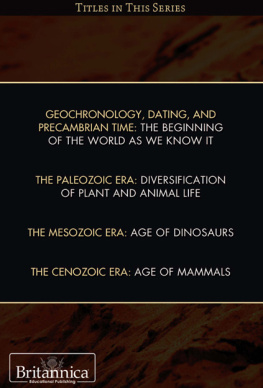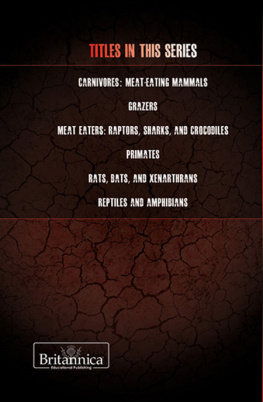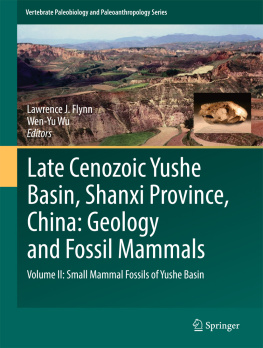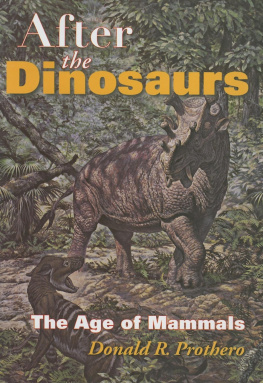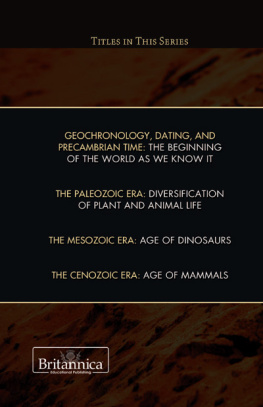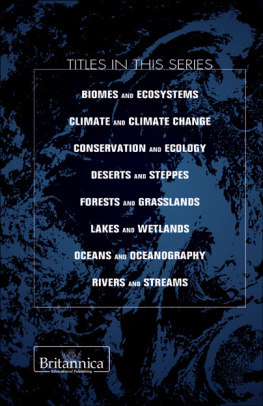THE CENOZOIC ERA
AGE OF MAMMALS
THE GEOLOGIC HISTORY OF EARTH
THE CENOZOIC ERA
AGE OF MAMMALS
EDITED BY JOHN P. RAFFERTY, ASSOCIATE EDITOR, EARTH SCIENCES

Published in 2011 by Britannica Educational Publishing
(a trademark of Encyclopdia Britannica, Inc.)
in association with Rosen Educational Services, LLC
29 East 21st Street, New York, NY 10010
Copyright 2011 Encyclopdia Britannica, Inc. Britannica, Encyclopdia Britannica, and the Thistle logo are registered trademarks of Encyclopdia Britannica, Inc. All rights reserved.
Rosen Educational Services materials copyright 2011 Rosen Educational Services, LLC.
All rights reserved.
Distributed exclusively by Rosen Educational Services.
For a listing of additional Britannica Educational Publishing titles, call toll free (800) 237-9932.
First Edition
Britannica Educational Publishing
Michael I. Levy: Executive Editor
J.E. Luebering: Senior Manager
Marilyn L. Barton: Senior Coordinator, Production Control
Steven Bosco: Director, Editorial Technologies
Lisa S. Braucher: Senior Producer and Data Editor
Yvette Charboneau: Senior Copy Editor
Kathy Nakamura: Manager, Media Acquisition
John P. Rafferty: Associate Editor, Earth Sciences
Rosen Educational Services
Heather M. Moore Niver: Rosen Editor
Nelson S: Designer
Cindy Reiman: Photography Manager
Matthew Cauli: Designer, Cover Design
Introduction by Cathy Vanderhoof
Library of Congress Cataloging-in-Publication Data
The Cenozoic era : age of mammals / edited by John P. Rafferty.
p. cm. (The geologic history of Earth)
In association with Britannica Educational Publishing, Rosen Educational Services
Includes bibliographical references and index.
ISBN 978-1-61530-194-2 (eBook)
1. Geology, StratigraphicCenozoic. 2. PaleoecologyCenozoic. 3. Paleontology
Cenozoic. I. Rafferty, John P.
QE690.C416 2011
560.178dc22
2010010471
Manufactured in the United States of America
On the cover: Extinction of the rapacious reptile transformed Earths population as the mammal flourished throughout the Cenozoic era. Manoj Shah/Stone/Getty Images
On : The Mississippi River is associated with large marine delta deposits of Quaternary age. James L. Stanfield/National Geographic/Getty Images
On : Lucy, the most famous Australopithecus fossil specimen, dates back to the Late Pliocene Epoch. Dave Einsel/Getty Images
CONTENTS









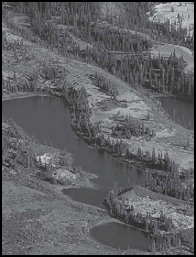




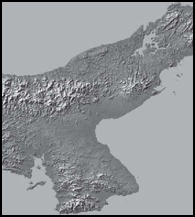


INTRODUCTION

W oolly mammoths, sabre-toothed tigers, ice ages covering the Earth, the formation of the Grand Canyonand us! All are part of the third major era in Earths history, known as the Cenozoic era, or era of modern life. Beginning after the great extinction of the dinosaurs, which ended the Mesozoic Era, and continuing to life today, this book provides a lively journey through the Cenozoic Era: the latest chapter in our planets continuing story of evolution and change.
The Cenozoic Era began about 65.5 million years ago, at a time when Earths climate was warm, sea levels were high, and reptiles were the dominant life-forms on Earth. During the ensuing millions of years, mammals became most prominent, humans evolved, plant life diversified, and sharply differentiated climate zones became the norm. The Cenozoic also saw the formation of many of Earths great mountain ranges, including the Alps, Himalayas, and Rocky Mountains of the American West.
Nineteenth-century geologists divided the Cenozoic into two major subdivisions: the Tertiary, spanning the interval from the beginning of the Cenozoic Era to the base of the Pleistocene Epoch, and the Quaternary, from the onset of the Pleistocene Epoch to the present. Scientists now agree on dividing the era into three major periods, splitting the traditional Tertiary Period into the Paleogene (65.5 million to 23 million years ago) and the Neogene (23 million to 2.6 million years ago). Each period is divided into several smaller intervals. The Paleogene Period is made up of the Paleocene Epoch, from 65.5 million to 55.8 million years ago, the Eocene, from 55.8 to 33.9 million years ago, and the Oligocene, from 33.9 to 23 million years ago. The Neogene encompasses the Miocene epoch, from 23 million to 5.3 million years ago and the Pliocene, from 5.3 to 2.6 million years ago. The third period, still known as the Quaternary, is divided into the Pleistocene Epoch, from 2.6 million to 11,700 years ago, and the Holocene, from 11,700 years ago to the present.
The early Tertiary, or Paleogene, Period was one of the warmest periods in Earths history, with little temperature difference between the polar regions and the equator. Life in the oceans had been decimated by the K-T mass extinction event, at the end of the Cretaceous Period. This was accompanied by the disappearance of the dinosaurs on land. During the next 10 million years, from the beginning of the Paleocene to the beginning of the Eocene Epoch, more than 20 orders of mammals rapidly evolved to fill this gap, along with a variety of large flightless birds. An extinction event near the end of the Paleocene Period replaced some earlier mammalian species with ancestors of many of the animals we know today. Mammals such as primitive horses, deer, rodents, hares, and early primates all appeared during the Eocene Epoch.
Next page
